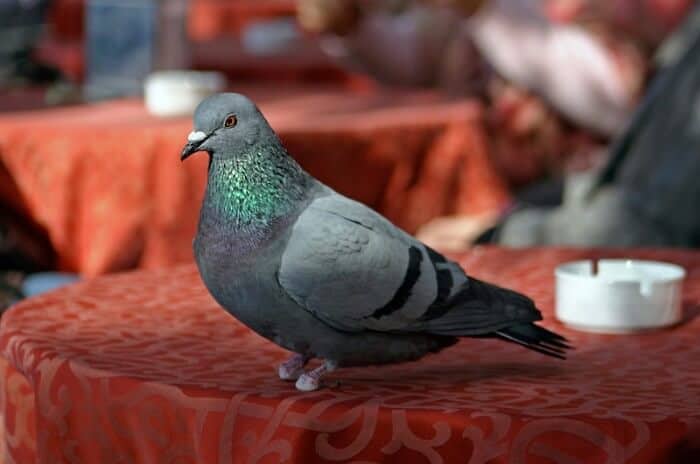If you’ve ever watched the pigeons that live in your community, you’ve likely noticed that their feet don’t always look healthy and well-formed.
If you have pet pigeons, it’s a good idea to understand what leads to foot problems in your pet so that you can prevent them from affecting your bird.
Even if you don’t keep pigeons as pets, you can do your part to take care of community birds by knowing what steps to take to help them keep their feet healthy and strong.
Read more to find out about why pigeons have bad feet and the causes.
Types of Foot Problems in Pigeons
There are several foot issues that pigeons may deal with through their lifetime. Many of them have missing toes, swelling in their toes, pedal deformities, or they may lose a foot altogether.
Obviously, this can interfere with their comfort and ability to stay safe, so knowing how to prevent these problems is important, for animal lovers, pigeon pet owners and responsible citizens.
1. Infections
Some research indicates that pigeons may wind up with missing toes or deformed feet due to infection. Pigeons tend to walk around in areas that might not be very clean and exposure to some kinds of germs and bacteria can lead to infections.
Infections are more common if the bird’s foot already has an injury of some kind. The bacteria enters the pigeon’s bloodstream and causes inflammation in its foot. Sometimes the infection may clear up, while other times it can cause lasting damage to the pigeon’s feet.
2. Chemical Pollutants
There’s a possibility that exposure to chemicals can also lead to foot problems in pigeons.
When they walk around on the ground, they may come into contact with a variety of chemicals that drip out of cars or otherwise end up on the streets and sidewalks.
Some of them are dangerous and can cause issues for their feet. In some cases, exposure to these chemicals may cause reproductive disturbances that can cause new baby pigeons to be born with deformities in their feet.
3. Human Hair
Research conducted in France finds that human hair may also contribute to the foot problems that many city-dwelling pigeons face.
The study found that there were more deformed pigeons in areas of the city where there was a high concentration of hairdressers.
When pigeons walk on human hair, it can become entangled on their toe digits, getting tighter and tighter.
This interrupts proper airflow to the area, which can cause deformities and even the loss of one or more toes.
This can also happen with string and wire and leads to a condition called stringfoot.
4. Pooping Deterrents
Many cities claim pigeons as a big problem as there are so many of them and people worry that they are dirty and carry diseases.
Many building owners and operators want to keep the pigeons from pooping all over the place as this creates a big and often expensive mess to clean up. To do this they often use chemical deterrents to prevent them from wanting to perch on the building.
However, if a pigeon gets this deterrent on its feet, it can lead to infections and poisoning that leaves the pigeon with deformed or swollen feet.

5. Their Own Excrement
Another issue that pigeons face is that they often perch in their own fecal matter.
This exposes their feet to a variety of bacteria that can be harmful. If one pigeon has a disease or condition that leads to foot problems, it can sometimes be passed to other pigeons via their poop.
6. Industrial and City Damage
Sometimes the cause of a pigeon’s foot problem is an injury. This is more common in densely populated areas where birds are more likely to come into contact with human refuse (such as debris spilling out of rubbish bins) or anti-pigeon spikes placed on buildings that can injure their feet if they walk on it.
Pigeons who live in or roost near train tracks are prone to foot injuries.
Researchers have found that pigeons who live in parks or open green spaces suffer far fewer foot problems than those who live in the city.
7. Genetics
One other cause of foot problems in pigeons is genetics. Just like humans, some foot issues can be passed from parents to their babies, which can lead to pigeons that are born with deformities or health problems that contribute to swollen toes, missing digits, or loss of a foot.
This can be a result of a chromosomal abnormality, exposure to chemicals in the parent birds or can be chalked up to chance.
How Foot Problems Affect Pigeons
Unfortunately, missing toes, missing a foot or having swelling or other foot problems can make it hard for a pigeon to function and take care of itself.
You may see these birds flying and walking around, but there are some issues they face.
A bird that can’t keep its balance properly may have trouble grooming itself and likely has ratty or missing feathers or a buildup of debris on its body.
Birds that aren’t able to groom like they should are at a higher risk of being infected with parasites such as feather mites and may have trouble feeding themselves.
Pigeons who aren’t groomed well are less attractive to mates and could suffer issues from being lonely and frustrated. These birds may not be able to protect themselves from their natural predators, vehicles and humans, which puts them at a higher risk of injury or death.
Pigeons make good pets because they are generally attractive and mild-mannered. Taking care of them in your home protects them from suffering serious foot issues.
Many people think pigeons are dirty and disease-ridden, but most of their foot problems can be blamed on humans so it makes sense to take steps to protect and care for them so we can all benefit.

This article was written by our qualified veterinarian Cristina.
This is part of our commitment to providing you with the most trustworthy veterinary advice for your pigeons.
Sources:
